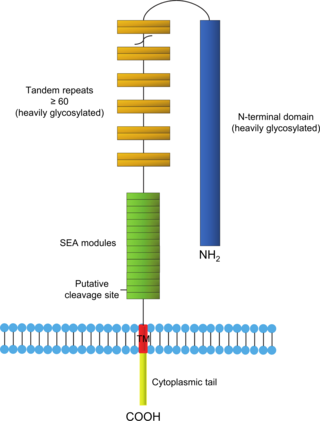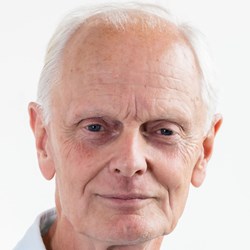
Mucin-16(MUC-16) also known as Ovarian cancer-related tumor marker CA125 is a protein that in humans is encoded by the MUC16 gene. MUC-16 is a member of the mucin family glycoproteins. MUC-16 has found application as a tumor marker or biomarker that may be elevated in the blood of some patients with specific types of cancers, most notably ovarian cancer, or other conditions that are benign.

Mucins are a family of high molecular weight, heavily glycosylated proteins (glycoconjugates) produced by epithelial tissues in most animals. Mucins' key characteristic is their ability to form gels; therefore they are a key component in most gel-like secretions, serving functions from lubrication to cell signalling to forming chemical barriers. They often take an inhibitory role. Some mucins are associated with controlling mineralization, including nacre formation in mollusks, calcification in echinoderms and bone formation in vertebrates. They bind to pathogens as part of the immune system. Overexpression of the mucin proteins, especially MUC1, is associated with many types of cancer.

Sir Richard Timothy Hunt, is a British biochemist and molecular physiologist. He was awarded the 2001 Nobel Prize in Physiology or Medicine with Paul Nurse and Leland H. Hartwell for their discoveries of protein molecules that control the division of cells. While studying fertilized sea urchin eggs in the early 1980s, Hunt discovered cyclin, a protein that cyclically aggregates and is depleted during cell division cycles.

The National Institute for Medical Research, was a medical research institute based in Mill Hill, on the outskirts of north London, England. It was funded by the Medical Research Council (MRC);

Receptor tyrosine-protein kinase erbB-2 is a protein that normally resides in the membranes of cells and is encoded by the ERBB2 gene. ERBB is abbreviated from erythroblastic oncogene B, a gene originally isolated from the avian genome. The human protein is also frequently referred to as HER2 or CD340.
Karen Heather Vousden, CBE, FRS, FRSE, FMedSci is a British medical researcher. She is known for her work on the tumour suppressor protein, p53, and in particular her discovery of the important regulatory role of Mdm2, an attractive target for anti-cancer agents. From 2003 to 2016, she was the director of the Cancer Research UK Beatson Institute in Glasgow, UK, moving back to London in 2016 to take up the role of Chief Scientist at CRUK and Group Leader at the Francis Crick Institute.

Mucin short variant S1, also called polymorphic epithelial mucin (PEM) or epithelial membrane antigen (EMA), is a mucin encoded by the MUC1 gene in humans. Mucin short variant S1 is a glycoprotein with extensive O-linked glycosylation of its extracellular domain. Mucins line the apical surface of epithelial cells in the lungs, stomach, intestines, eyes and several other organs. Mucins protect the body from infection by pathogen binding to oligosaccharides in the extracellular domain, preventing the pathogen from reaching the cell surface. Overexpression of MUC1 is often associated with colon, breast, ovarian, lung and pancreatic cancers. Joyce Taylor-Papadimitriou identified and characterised the antigen during her work with breast and ovarian tumors.

Mucin-4 (MUC-4) is a mucin protein that in humans is encoded by the MUC4 gene. Like other mucins, MUC-4 is a high-molecular weight glycoprotein.

Terence Howard Rabbitts FRS FMedSci is currently Professor of Molecular Immunology at the Institute of Cancer Research, London.
Sheena Elizabeth Radford FRS FMedSci is a British biophysicist, and Astbury Professor of Biophysics in the Astbury Centre for Structural Molecular Biology, School of Molecular and Cellular Biology at the University of Leeds. Radford is the Associate Editor of the Journal of Molecular Biology.

David Ron FRS is a British biochemist.

Sir James Cuthbert Smith is Director of Science at the Wellcome Trust, Senior Group Leader at the Francis Crick Institute and President of the Council at Zoological Society of London.
David Chaim Rubinsztein FRS FMedSci is the Deputy Director of the Cambridge Institute of Medical Research (CIMR), Professor of Molecular Neurogenetics at the University of Cambridge and a UK Dementia Research Institute Professor.

Mucin-1(MUC-1) is a heterodimer transmembrane protein of the mucin family encoded in humans by the MUC1 gene. It is cleaved into two chains: Mucin-1 subunit alpha and Mucin-1 subunit beta. These subunits differ in size due to proteolytic cleavage of the translated precursor protein in the Endoplasmic Reticulum. The larger subunit of MUC-1 is characterized by numerous O-glycosylation bonds and a terminal sialic acid, creating a net negative charge on MUC-1. The smaller subunit contains a juxtamembrane region of the extracellular area, a transmembrane domain, and the cytoplasmic tail. The extracellular domain of MUC-1 is composed of 20 identical amino acid tandem repeats (TR). Each tandem repeat contains two Serine and three Threonine amino acid residues, providing five sites for potential O-glycosylation. MUC-1 protein is estimated to weigh 120-225 kDA.

(Edith) Yvonne JonesFLSW is director of the Cancer Research UK Receptor Structure Research Group at the University of Oxford and a Fellow of Jesus College, Oxford. She is widely known for her research on the molecular biology of cell surface receptors and signalling complexes.

Anne Jacqueline Ridley is professor of Cell Biology and Head of School for Cellular and Molecular Medicine at the University of Bristol. She was previously a professor at King's College London.

Roger Lee Williams is a structural biologist and group leader at the Medical Research Council (MRC) Laboratory of Molecular Biology. His group studies the form and flexibility of protein complexes that associate with and modify lipid cell membranes. His work concerns the biochemistry, structures and dynamics of these key enzyme complexes.

Richard Malcolm Marais is Director of the Cancer Research UK (CRUK) Manchester Institute and Professor of Molecular Oncology at the University of Manchester.

(Robert) Charles Swanton is British physician scientist specialising in oncology and cancer research. Swanton is a senior group leader at London's Francis Crick Institute, Royal Society Napier Professor in Cancer and thoracic medical oncologist at University College London and University College London Hospitals, co-director of the Cancer Research UK (CRUK) Lung Cancer Centre of Excellence, and Chief Clinician of Cancer Research UK.
Eric Ofori Aboagye is a Professor of Cancer Pharmacology and Molecular Imaging at Imperial College London. He is a Fellow of the Academy of Medical Sciences and was awarded the British Institute of Radiology Sir Mackenzie Davidson Medal in 2009. He is co-director of the Imperial College London Experimental Cancer Medicine's Centre.















